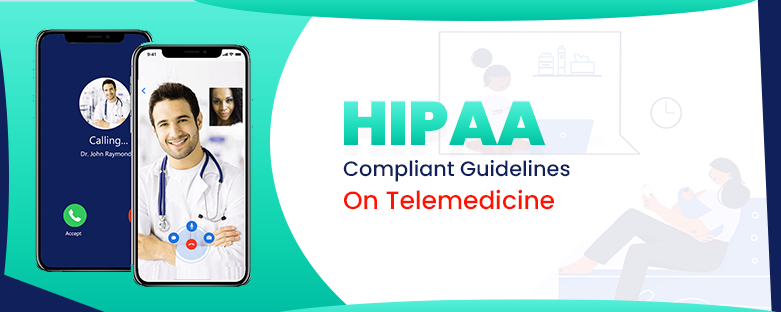HIPAA Guidelines on Telemedicine
Guidelines and stringent, cautious guidelines for how to protect the privacy details of all of the customers are given by the Health Insurance Portability and Accountability Act (HIPAA). The aim of HIPAA Guidelines on Telemedicine is to ensure there is no compromising on confidential and private patient records.
Compliance with HIPAA may be as complex as providing a safe sign-in sheet at the reception desk to encrypt millions of pieces of record-keeping, file sharing, upload, and billing details.
WHAT IS HIPAA?
HIPAA is the acronym for the Health Insurance Portability and Accountability Act which Congress passed in 1996. HIPAA does the following:
- Provides the ability for millions of American workers and their families to transfer and continue health insurance coverage once they change or lose their jobs
- Decreases fraud and violence of health-care
- Mandates industry-wide health care information standards regarding electronic billing and other processes.
- Needs the protection and confidential handling of protected health information
What Does HIPAA Protect?
Protected Health Information (PHI) is the primary issue of HIPAA and consists of:
- The personal information of the patient, such as name, age, and occupation.
- Identifiable patient records such as their photos, fingerprints, phone number, and address.
- Record of the past history of the patient and on-going therapies.
- It also provides medical records with families and often also social structure.
Why HIPAA Complaint?
Security is the highest priority for any company, so your application should be safeguarded with HIPAA compliance with that concern. If your application is protected by HIPAA, then you will have benefits specified to satisfy all your specifications, such as safe user verification, saving legal documents, producing reports, and so on. The aim was to deter abuse in healthcare and guarantee that all ‘safe health records’ was adequately guarded and limit approved individuals’ access to health data.
Objectives of HIPAA
The crucial objectives and targets around which HIPAA revolves are as follows:
- Confidentiality of health records
- Security of electronic records
- Simplification of Administrative
- Portability of Insurance
What is HIPAA Compliance Checklist?
Here are the critical features ensuring which will make sure your software is compliant with HIPAA guidelines:
- Ensure password-protected system access
- Access control to be maintained
- Authorization monitoring by admins
- Data backup to ensure retrieval
- Proactive remediation strategy should be ensured
- Emergency mode
- Automated log out if the system is not accessed for long
- Data storage with encryption and decryption
Benefits of HIPAA Compliance:
There are many benefits of HIPAA compliance, some are given below:
1. Decreases the Number of Medical Mistakes in Busy Systems
When creating medical reports, HIPAA helps clinicians and patients to work together. Since several people are associated with each object, the risks of mistakes are significantly reduced. This approach increases the overall level of treatment rendered by patients when physicians and nurse practitioners have faith in data quality before them.
2. Profitability
If, due to loyalty, you attract more patients/clients, the organization’s revenue increases. Retaining current patients/clients means growing the recurring sales, meaning that less new business is expected to remain sustainable for the company.
3. Patient Trust
Large-scale data breaches continue to occur at an unprecedented pace, including those seen in recent years. These may add to major reputational harm that can result in permanent damage. Maintaining patient trust over time also includes maintaining compliance with HIPAA and a comprehensive framework for data management based on patient data safety.
The opportunity to reduce the chance of data loss is one of the key advantages of HIPAA compliance. In comparison, it is going to be less disruptive if a violation happens. External intrusions like data breaches are more likely to be detected earlier than later with a robust data security strategy in place, mitigating the severity of the breach and limiting the effect on the brand and credibility.
Myths of HIPAA-compliant Software:
Myth 1: For All Health info, HIPAA Applies To
In particular, HIPAA only refers to a narrow concept of health records and data, including only data kept by the doctor or healthcare team of a patient. For instance, if you report your morning weight, sleep cycles, or glucose levels and use a fully patient-facing smartphone app or website, then that application or website is not accountable or kept to HIPAA requirements.
However, once you report the same information on a doctor’s open mobile site (i.e. a health log or healthcare portal), the information becomes the responsibility of the doctor to protect and is covered by his or her laws.
Myth 2: Healthcare Providers are Free to Share PHI with Employers
HIPAA bans employers from viewing the health records of an employee, regardless of the fact that they pay for their services. When an employer decides to have access to your health records, they require your express consent to do so. Similarly, without the informed permission of the patient, it also forbids healthcare providers from exchanging any data points protected by PHI with others.
Myth 3: You’ve Just Got to Think About it Once
If HIPAA was something you just had to contend with once, that would be great. But it’s not something that you should put once in order and then forget about.
In fact, HIPAA is an ongoing duty and businesses need to actively track their own enforcement. As in most forms of problems that involve commitment and motivation, over time, individuals can tend to take shortcuts. Ensure that your business has a well-defined and well-funded HIPAA compliance plan.
HIPAA Privacy & Security Rules:-
After HIPAA officially became law, the United States Department of Health and Human Services began working on the Act’s Privacy and Security Rules. The Privacy Rules came into force on 14 April 2003.
These regulations specifically considered that Protected Health Information (PHI) is any information in the hands of a covered agency relating to the provision of medical treatment, health status or payment that may be connected to a particular individual.
Instructions were also provided on how to divide this information, and that the individual’s permission must be obtained before their PHI is used for research, marketing, or fundraising. In addition, patients were given the right to hide their health-related information from insurance companies if their care is privately funded.
HIPAA’s Security Rules became effective two years later on April 21, 2005. These governed the use of electronically stored PHI (ePHI) and created three security layers: technical, physical, and administrative. Under HIPAA, adherence to those rules is required. They each have the intended purpose:
Technical: To safeguard media containing PHI when electronically transmitted across open networks
Physical: To restrict access to information storage areas and prevent unauthorized access
Administrative: To put procedures and policies in place to delineate how an entity must comply with HIPAA.
HIPAA Compliance In Telemedicine:
Medical professionals often mistakenly believe that ePHI communication is acceptable when the communication between doctor and patient is direct. Often, the medium of communication that is used to communicate ePHI is little regard.
Medical professionals wishing to comply with the HIPAA Guidelines on Telemedicine must adhere to rigorous standards for such communications to be deemed compliant. :
- The ePHI should only be access to authorized users.
- To safeguard the integrity of ePHI a safe communication system should be implemented.
- To avoid accidental or malicious breaches, a communications control system that includes ePHI should be implemented.
Third Party Data Storage
A medical professional or healthcare company that produces ePHI that is collected by a third party must have a Business Associate Agreement (BAA) with the data held by the client.
The BAA should include procedures used by the third-party to ensure data safety, and arrangements for periodic data security auditing.
Who is a Business Associate?
Any individual or entity conducting tasks or activities on behalf of a covered entity needs the business associate to access PHI is called the business associate. The person or organization can also provide a service to a covered entity.
Examples of Business Associates:
A third-party administrator who helps a health plan with claims processing.
A CPA firm whose accounting services include access to protected health information to a health care provider.
An independent medical transcriber who provides physician transcription services
A manager of pharmacy services, who oversees the pharmacist network of a health program.
Ensure Your System Is HIPAA – Compliant
Before setting up a telehealth practice, make sure that HIPAA enforcement is known to the technical experts you are recruiting. Ask to see their methods of access controls and data encryption. Additionally, evaluate the system’s backup and disaster plans. These should include offsite backup options in the event of catastrophic breaches or system crashes. Finally, make sure that every member of staff in your technology provider is familiar with HIPAA, dedicated to compliance, and willing to participate in regular internal audits. Ask for copies of the disaster recovery plan from your vendor, as well as credentials and instructions for access control.
Some concluding thoughts on the HIPAA Guidelines on Telemedicine:
Initially, secure messaging technologies were designed to promote HIPAA compliant messaging, but many of the features of secure messaging have resulted in benefits that have improved healthcare professionals’ workflows, lowered medical facility costs and increased the standard of healthcare received by patients.
Most healthcare organizations have been pleasantly surprised at the simplicity with which to comply with the HIPAA Guidelines on Telemedicine can be, and even more pleasantly surprised at the expense with no need to invest in costly hardware or complex software, or finish the organizations IT resources.
The HIPAA Guidelines on Telemedicine make it very clear what steps need to be placed in place to ensure the safety of ePHI. With major advantages to introducing a secure messaging solution, it is just a question of time before all covered entities providing a telemedicine service are communicating with the secure messaging ePHI at distance.
Conclusion:
We works for the Healthcare IT Services in India and in our best services we include Healthcare Software Solution, EMR Software and also have best practices in Wearable App Development Company for the healthcare purpose. We feel proud to say that we work for our India, USA, Australia and UAE based clients.
Contact Us – (+1)-949-340-7490 | Mail at enquiry@dreamsoft4u.com





Thanks for sharing the HIPPA guideline information on telemedicine in this post. It’s informative, and UI is fantastic to read the post.